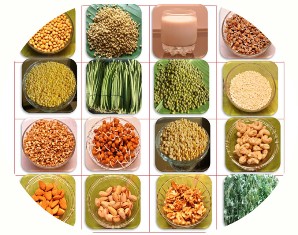PROTEIN DEFICIENCY DISEASE
PROTEIN ENERGY MALNUTRITION (PEM)
The term protein energy malnutrition covers a wide spectrum of clinical stages ranging from the severe forms like kwashiorkor and marasmus to the milder forces in which the main detectable manifestation is growth retardation. It is widely prevalent among weaned infants and pre-school children in India and other developing countries.
|
CAUSES
1. Social and Economic Factors
Poverty that results in low food availability, overcrowded and unsanitary living conditions and improper child care are frequent causes of PEM. A decline in the practice and duration of breast feeding combined with inadequate weaning practices are the important causes of PEM.
2. Biological factors
Maternal malnutrition prior to and or during pregnancy is more likely to produce an underweight new born baby. Infectious diseases are major contributing and precipitating factors of PEM. Diarrhoea, measles and respiratory and other infections result in negative protein and energy balance.
3. Environmental factors
Overcrowded and or unsanitary conditions lead to frequent infections like diarrhoea. Agricultural patterns, droughts, floods, earthquakes, wars and forced migrations lead to cyclic, sudden or prolonged food scarcities. Post harvest losses of food can occur due to bad storage conditions and inadequate food distribution.
4. Age
It mostly affects infants and young children whose rapid growth increases nutritional requirement. The long term intake of insufficient food can result in marasmus before one year. Kwashiorkar is common after 18 months.
KWASHIORKOR
symptoms
-
Growth failure due to general lack of proteins and calories.
-
Mental changes such as apathy and irritability.
-
Muscle wasting.
-
Oedema occurs at first in the feet and lower leg and then may involve the hands, thigh and face.
-
Moon face.
-
Fatty and enlarged liver
-
Loss of appetite, vomiting and diarrhoea
-
Characteristic skin changes which include dark pigmented brownish black areas of skin on buttocks and back of thighs called as crazy pavement dermatosis.
-
Hair changes
-
Anaemia
-
Vitamin A deficiency
|
|
|
-
severe growth retardation
-
loss of subcutaneous fat
-
severe muscle wasting
-
The child looks appallingly thin with shriveled body, wrinkled skin and bony prominence
MARASMIC KWASHIORKAR
The child shows a mixture of some of the features of marasmus and kwashiorkar.
NUTRITIONAL DWARFING OR STUNTING
Some children adapt to prolonged insufficiency of food-energy and protein by a marked retardation of growth. Weight and height are both reduced and in the same proportion, so they appear superficially normal.
UNDERWEIGHT CHILD
Children with sub-clinical PEM can be detected by their weight for age or weight for height, which are significantly below normal. They may have reduced plasma albumin. They are at risk for respiratory and gastric infections. |
TREATMENT
Treatment strategy can be divided into three stages.
- Resolving life threatening conditions
- Restoring nutritional status
- Ensuring nutritional rehabilitation.
There are three stages of treatment.
1. Hospital Treatment
The following conditions should be corrected. Hypothermia, hypoglycemia, infection, dehydration, electrolyte imbalance, anaemia and other vitamin and mineral deficiencies. |
|
| 2. Dietary Management |
Protein Rich Food |
The diet should be from locally available staple foods - inexpensive, easily digestible, evenly distributed throughout the day and increased number of feedings to increase the quantity of food.
3. Rehabilitation
The concept of nutritional rehabilitation is based on practical nutritional training for mothers in which they learn by feeding their children back to health under supervision and using local foods.
PREVENTION
-
Promotion of breast feeding
-
Development of low cost weaning
-
Nutrition education and promotion of correct feeding
-
practices
-
Family planning and spacing of births
-
Immunisation
-
Food fortification
-
Early diagnosis and treatment
|
Source
http://mydreambaby.in/wp-content/uploads/2012/07/Garbhakranti-protein-rich-foods-during-pregnancy.jpg
http://www.corebloggers.com/blog/wp-content/uploads/2013/09/en.jpg
|
|



